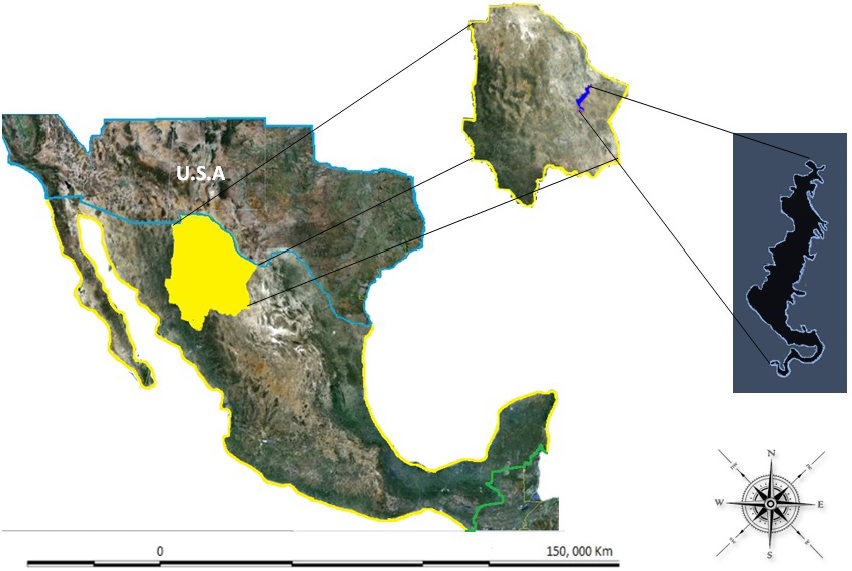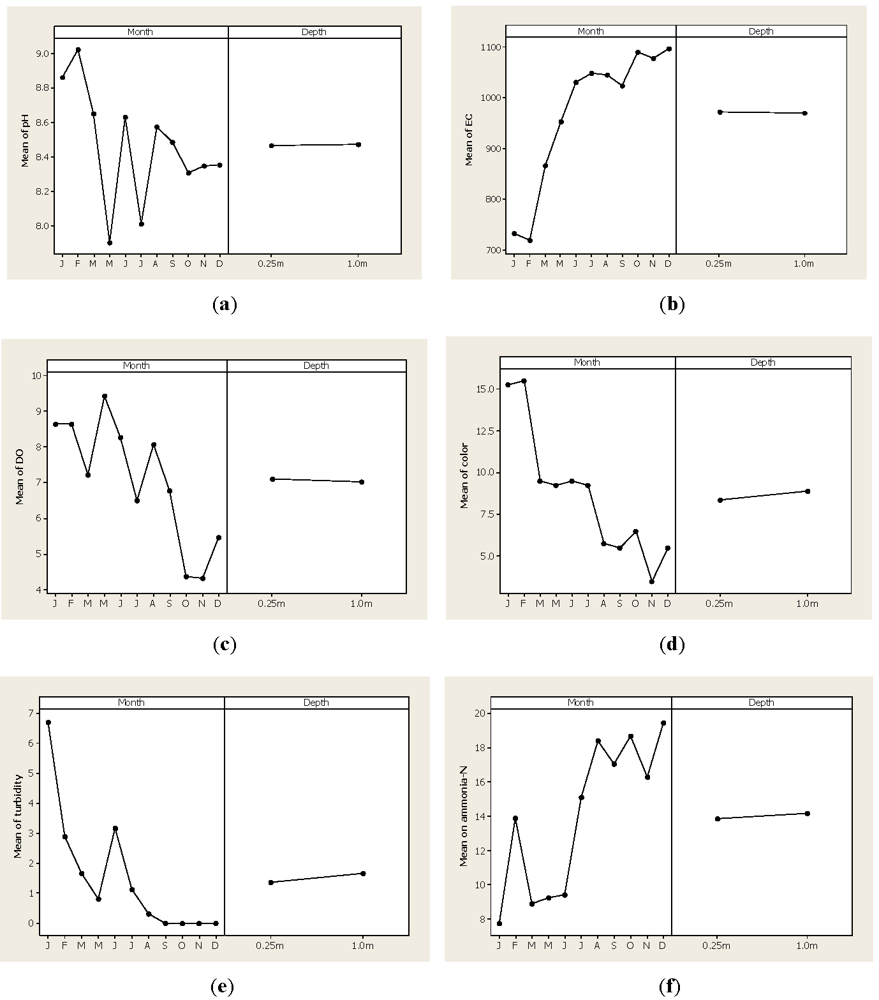An Overall Water Quality Index (WQI) for a Man-Made Aquatic Reservoir in Mexico
Abstract
:1. Introduction
2. Materials and Methods


3. Results and Discussion




Conclusions
Acknowledgments
References
- Horton, R.K. An index-number system for rating water quality. J. Water Pollut. Control Fed. 1965, 37, 300–306. [Google Scholar]
- Alobaidy, A.H.M.J.; Haider, A.; Bahram, M. Application of water quality index for assessment of Dokan Lake Ecosystem, Kurdistan Region, Iraq. J. Water Resour. Prot. 2010, 2, pp. 792–798. Available online: http://www.highbeam.com/doc/1P3-2312345991.html (accessed on 19 October 2011).
- Mondal, D.K.; Anilava, K.; Subtrata, S. Water quality parameters and fish biodiversity as measures of ecological degradation: A case study in two floodplain lakes of India. J. Water Resour. Prot. 2010, 2, 85–92. [Google Scholar] [CrossRef]
- Zhu, L.; Hu, H. Fuzzy complex index in water quality assessment of municipalities. J. Water Resour. Prot. 2010, 2, pp. 809–813. Available online: http://www.highbeam.com/doc/1P3-2312125411.html (accessed on 19 October 2011).
- De la Mora, O.C.; Rubio-Arias, H.; Garcia-Velasco, J. Indice de calidad de agua en el lago de Chapala, Jalisco, Mexico. In Contribucion al Estudio de los Servicios Ambientales; Libro tecnico num. 1.; CIRPAC-INIFAP: Mexico City, Mexico, 2005; pp. 33–52. [Google Scholar]
- Yisa, J.; Jimoh, T. Analytical studies on water quality index of River Landzu (Report). Am. J. Appl. Sci. 2010, 7, pp. 453–458. Available online: http:/www.highbeam.com/doc/1G1-227444198.html (accessed on 19 October 2011).
- Alobaidy, A.H.M.J.; Bahram, M.; Abass, K. Evaluating raw and treated water quality of Tigris River within Baghdad by index analysis (Report). J. Water Resour. Prot. 2010, 2, pp. 629–635. Available online: http://www.highbeam.com/doc/1G1-265290979.html (accessed on 19 October 2011).
- Cocchi, D.; Scagliarini, M. Modeling the effect of salinity on the multivariate distribution of a water quality index. J. Math. Stat. 2005, 1, pp. 268–272. Available online: http:/www.highbeam.com/doc/1G1-151317793.html (accessed on 19 October 2011).
- Love, J.W.; May, E.B. Relationships between fish assemblage structure and selected environmental factors in Maryland’s Coastal Bays. Northeast. Nat. 2007, 14, pp. 251–268. Available online: http://www.highbeam.com/doc/1P3-1302555801.html (accessed on 19 October 2011).
- Nasirian, M. A new water quality index for environmental contamination contributed by mineral processing: A case study of amang (Tin Tailing) processing activity. J. Appl. Sci. 2007, 7, 2977–2987. [Google Scholar] [CrossRef]
- Simoes, F.S.; Moreira, A.B.; Bisinoti, M.C.; Gimenez, M.N.S.; Yabe, M.J.S. Water quality index as a simple indicator of aquaculture effects on aquatic bodies. Ecol. Indic. 2008, 8, 476–484. [Google Scholar]
- Comision Nacional del Agua, Estadisticas del Agua en Mexico, 2010 edSEMARNAT, Gobierno Federal: Mexico City, Mexico, 2010.
- Colegio de Estudios AmbientalesAsociacion Civil.El Agua en Chihuahua: Un Ejemplo de Mala Gestión; Colegio de Estudios Ambientales: Chihuahua, Mexico, 2007.
- Schmidt, J.C.; Everitt, B.C.; Richard, G.A. Hydrology and geomorphology of the Rio Grande and Implications for River Rehabilitation. In Aquatic Fauna of the Northern Chihuahuan Desert; Garret, G.P., Allan, A.L., Eds.; Museum of Texas: Lubbock, TX, USA, 2003; pp. 25–45, Special publication No. 46. [Google Scholar]
- Gutiérrez, M.; Borrego, P. Water quality assessment of the Rio Conchos, Chihuahua, Mexico. Environ. Intern. 1999, 25, 573–583. [Google Scholar]
- Gutiérrez, M.; Martinez-Pina, J.; Luo, K.M. Geochemical processes contributing to the contamination of soil and surface waters in the Rio Conchos basin, Mexico. Geosphere 2008, 4, 600–611. [Google Scholar]
- Gutierrez, M.; Alarcon-Herrera, M.T; Camacho, L.M. Geographical distribution of arsenic in sediments within the Rio Conchos Basin, Mexico. Environ. Geol. 2009, 57, 929–935. [Google Scholar]
- Gutiérrez, M.; Carreon, E. Contenido de As, Ba, y Cu en sedimentos y su asociación con depósitos minerales en el noreste de Chihuahua (in Spanish). Tecnociencia Chihuahua 2008, 2, 108–117. [Google Scholar]
- Rubio-Arias, H.; Rey, N.I.; Quintana, R.M.; Nevarez, G.V.; Palacios, O. Coliform and metal contamination in Lago de Colina, a recreational water body in Chihuahua State, Mexico. Int. J. Environ. Res. Public Health 2011, 8, 2386–2400. [Google Scholar]
- Gutiérrez, M. Trace element concentration patterns in sediments of the lower Rio Conchos, Mexico. Water Air Soil Pollut. 2000, 121, 259–270. [Google Scholar]
- Rubio, A.H.; Wood, K.; Alanis, H.E. Water Pollution in the Rio Conchos of Northern Mexico. Develpment and Application of Computer Techniques to Environmental Studies X; Latini, G., Passerini, G., Brebbia, C.A., Eds.; Witpress: London, UK, 2004; pp. 167–176. [Google Scholar]
- Rubio-Arias, H.; Quintana, C.E.; Jimenez-Castro, J.; Quintana, R.M.; Gutierrez, M. Contamination of the Conchos River in Mexico: Does it pose a health risk to local residents? Int. J. Environ. Res. Public Health 2010, 7, 2071–2084. [Google Scholar]
- Holguin, C.; Rubio, H.; Olave, M.E.; Saucedo, R.A.; Gutiérrez, M.; Bautista, R.G. Calidad del agua del Río Conchos en la región de Ojinaga, Chihuahua: Parámetros Fisicoquímicos, metales y metaloides. Universidad y Ciencia 2006, 22, 51–63. [Google Scholar]
- Gutierrez, L.R.; Rubio-Arias, H.O.; Quintana, R.M.; Ortega, J.A.; Gutierrez, M. Heavy metals in water of the San Pedro River in Chihuahua, Mexico and its potential health risk. Int. J. Environ. Res. Public Health 2008, 5, 91–98. [Google Scholar]
- Aguas Residuales–Muestreo. In Norma Mexicana, NMX-AA-003-1980; México, 1980.
- Cuerpos Receptores–Muestreo. In Norma Mexicana, NMX-AA-014-1980; México, 1980.
- Procedimientos sanitarios para el muestreo de agua para uso y consumo humano en sistemas de abastecimiento de agua públicos y privados. In Norma Mexicana, NOM-014-SSA1-1993; Mexico, 1993.
- Análisis de Agua–Determinación de Color Platino Cobalto en Aguas Naturales, Residuales y Residuales Tratadas–Método de Prueba. Norma Mexicana, NMX-AA-045-SCFI-2001 2001.
- APHAAWWAWPCFStandard Methods for the Examination of Water and Wastewater, 20th ed; American Public Health Association, American Water Works Association and Water Pollution Control Federation: Washington, DC, USA, 1998.
- Análisis de agua–Determinación de nitrógeno total de kjeldahl en aguas naturales, residuales y residuales tratadas–Método de prueba. Norma Mexicana, NMX-AA-026-SCFI-2001 2001.
- Análisis de agua–Determinación de sólidos y sales disueltas en aguas naturales, residuales y residuales tratadas–Método de prueba. Norma Mexicana, NMX-AA-034-SCFI-2001 2001.
- Chapman, D.; Kimtsach, V. Selection of Water Quality Variables; Chapman, D., Ed.; Water quality assessments, UNESCO, WHO, United Nations Environment Programme, E & FN Spon: Londres, UK, 1992; pp. 59–126.
- Primavesi, O.; Ribeiro de Freitas, A.; Torres de Oliveira, H. Water quality of the Canchim’s Creek watershed in São Carlos, SP, Brazil, occupied by beef and dairy cattle activities. Braz. Arch. Biol. Technol. 2002, 45, 209–217. [Google Scholar]
- Escribano, M.; de Frutos, M. Impactos Sobre la Calidad de las Aguas Superficiales. In La Práctica de las Estimaciones de Impactos Ambientales; Fundación Conde del Valle de Salazar: Madrid, Spain, 1987; Volume 3, pp. 443–453. [Google Scholar]
- Said, A.; Stevens, D.; Sehlke, G. A innovative water quality index. Environ. Manag. 2004, 34, 406–414. [Google Scholar]
- Gaunt, P.; Barker, S. Matrix solid phase dispersion extraction of triazines from catfish tissues; examination of the effects of temperature and dissolved oxygen on the toxicity of atrazine. Int. J. Environ. Pollut. 2000, 13, 284–312. [Google Scholar] [CrossRef]
- Schuster, C.J.; Ellis, A.G.; Robertson, W.J.; Charron, D.F.; Aramini, J.J.; Marshall, B.J.; Medeiros, D.T. Temporal variation in drinking water turbidity and diagnosed gastroenteritis in Milwauke. Am. J. Public Health 1996, 86, 237–239. [Google Scholar]
- Schwartz, J.; Levin, R.; Hodge, K. Infectious disease outbreak related to drinking water in Canada 1974–2001. Can. J. Public Health 2005, 96, 254–258. [Google Scholar]
- Sabahi, E.A.; Rahim, A.; Zuhairi, W.; Fares, A.; Fadhi, N. Assessment of groundwater and surface water pollution at Mitm area, Ibb city, Yemen. Am. J. Appl. Sci. 2009, 6, pp. 772–783. Available online: http://www.highbema.com (accessed on 13 December 2011).
- Rejith, P.G.; Jeeva, S.P.; Vijith, M.; Sowmya, A.A.H. Determination of groundwater quality indez of a highland village of Kerala (India) using geographical information system. J. Environ. Health. 2009, 71, pp. 51–58. Available online: http://www.highbeam.com/doc/1G1-201031649.html (accessed on 14 December 2011).
- Rabee, A.M.; Bahha, A.K.; Ahmed, A. Seasonal variations of some ecological parameters in Tigris River water at Baghdad region Iraq. J. Water Resour. Prot. 2011, 3, pp. 262–267. Available online: http://www.highbeam.com/doc/1P3-2393444801.html (accessed on 14 December 2011).
© 2012 by the authors; licensee MDPI, Basel, Switzerland. This article is an open-access article distributed under the terms and conditions of the Creative Commons Attribution license (http://creativecommons.org/licenses/by/3.0/).
Share and Cite
Rubio-Arias, H.; Contreras-Caraveo, M.; Quintana, R.M.; Saucedo-Teran, R.A.; Pinales-Munguia, A. An Overall Water Quality Index (WQI) for a Man-Made Aquatic Reservoir in Mexico. Int. J. Environ. Res. Public Health 2012, 9, 1687-1698. https://doi.org/10.3390/ijerph9051687
Rubio-Arias H, Contreras-Caraveo M, Quintana RM, Saucedo-Teran RA, Pinales-Munguia A. An Overall Water Quality Index (WQI) for a Man-Made Aquatic Reservoir in Mexico. International Journal of Environmental Research and Public Health. 2012; 9(5):1687-1698. https://doi.org/10.3390/ijerph9051687
Chicago/Turabian StyleRubio-Arias, Hector, Manuel Contreras-Caraveo, Rey Manuel Quintana, Ruben Alfonso Saucedo-Teran, and Adan Pinales-Munguia. 2012. "An Overall Water Quality Index (WQI) for a Man-Made Aquatic Reservoir in Mexico" International Journal of Environmental Research and Public Health 9, no. 5: 1687-1698. https://doi.org/10.3390/ijerph9051687



